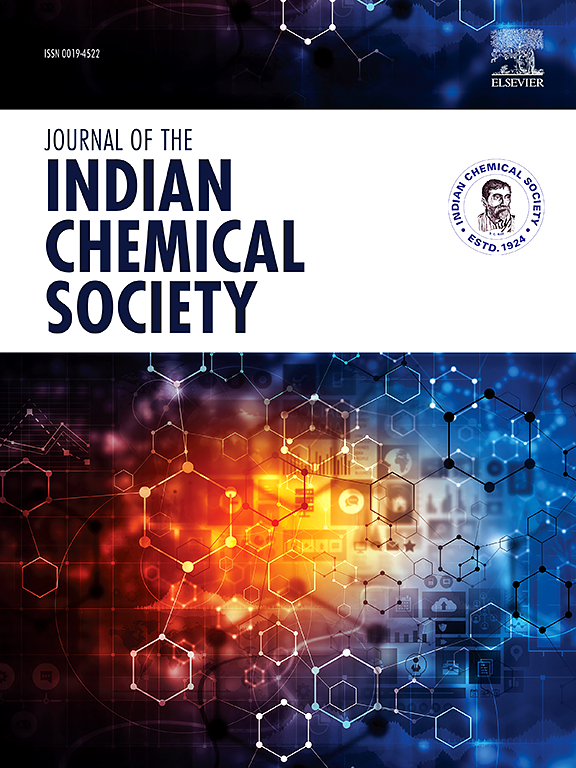超级电容器用红红球活性炭的过热蒸汽辅助纳米结构
IF 3.2
4区 化学
Q2 CHEMISTRY, MULTIDISCIPLINARY
引用次数: 0
摘要
活性炭孔结构与电解质种类之间的相互作用决定了超级电容器的性能。本文以LiPF6电池电解液为原料,利用对称超级电容器研究了红红球活性炭的孔隙结构,通过活化保留和电化学行为来定义其孔隙结构。活性炭样品在850°C的过热蒸汽条件下物理活化,不同的保留时间为30、60和90分钟(AC30、AC60和AC90)。此外,AC60在最终截留(AC60Tt)后不带蒸汽留在反应器中,观察超前孔隙形成。AC60Tt表现出以2 ~ 10 nm为中心的良好孔隙发育(78%)。合理的结果是最高的碘吸附量为901 mg/g, BET面积为587 m2/g。比邻和红外光谱实验表明,AC90的碳含量和CC官能团最高。通过伏安法分析,AC90在扫描速率为1 mV/s时的电容值为104 F/g;通过充放电分析,AC90在电位窗口为3.0 V时的电容值为157 F/g、196 Wh/kg和2941 W/g。AC90受益于最高浓度的介孔和双键,促进有效的电极/电解质相互作用。最后,本研究报告了一种简便、经济的活性炭生产技术,用于增强超级电容器的性能。本文章由计算机程序翻译,如有差异,请以英文原文为准。

Superheated steam-assisted nanoarchitectonics of red calliandra-delivered activated carbon for supercapacitor application
The interaction between the activated carbon pore structure and electrolyte species determines the performance of the supercapacitor. Herein, the pore texture of red calliandra-activated carbon, defined by activation retention and electrochemical behaviour, was investigated by a symmetric supercapacitor using LiPF6 battery electrolyte. Activated carbon samples were physically activated in superheated steam conditions at 850 °C with different retention times of 30, 60, and 90 min (AC30, AC60, and AC90). Additionally, AC60 was left in the reactor without steam after the final retention (AC60Tt) to observe advanced pore formation. AC60Tt exhibited excellent pore development centered at 2–10 nm (78 %). The logical consequence was the highest iodine adsorption of 901 mg/g and BET area of 587 m2/g. Proximate and FTIR experiments indicated that AC90 had the highest carbon content and C![]() C functional group. AC90 generates an impressive capacitance of 104 F/g at a scan rate of 1 mV/s by the voltammetry technique and 157 F/g, 196 Wh/kg, and 2941 W/g at a potential window of 3.0 V by charge-discharge analysis. AC90 benefits from the highest concentration of mesopores and double bonds, facilitating effective electrode/electrolyte interaction. Finally, the present study reports a facile, economical activated carbon production technique for enhanced supercapacitor performance.
C functional group. AC90 generates an impressive capacitance of 104 F/g at a scan rate of 1 mV/s by the voltammetry technique and 157 F/g, 196 Wh/kg, and 2941 W/g at a potential window of 3.0 V by charge-discharge analysis. AC90 benefits from the highest concentration of mesopores and double bonds, facilitating effective electrode/electrolyte interaction. Finally, the present study reports a facile, economical activated carbon production technique for enhanced supercapacitor performance.
求助全文
通过发布文献求助,成功后即可免费获取论文全文。
去求助
来源期刊
CiteScore
3.50
自引率
7.70%
发文量
492
审稿时长
3-8 weeks
期刊介绍:
The Journal of the Indian Chemical Society publishes original, fundamental, theorical, experimental research work of highest quality in all areas of chemistry, biochemistry, medicinal chemistry, electrochemistry, agrochemistry, chemical engineering and technology, food chemistry, environmental chemistry, etc.

 求助内容:
求助内容: 应助结果提醒方式:
应助结果提醒方式:


